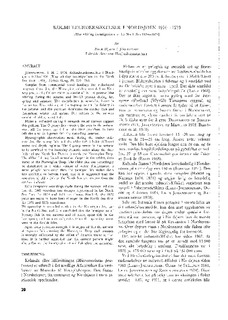| dc.description.abstract | Samples from commercial trawl landings for reductional purposes show that the Norwegian catches recorded as Norway
pout in the fishery statistics consist of 50—70 prosent blue whiting during the autumn and 30—60 prosent during late
spring and summer. The contribution is somewhat lower in the winter. Blue whiting of the 0-group enters the fishery in the autumn, and this yearclass dominates the catches then and throughout winter and spring. The
catches in the summer consist of older, spent fish. Material collected during 9 research vessel surveys support this pattern. The 0-group fish entering the area in the autumn seem all the years, apart from the 1969 yearclass, to have left the area as I-group fish the succeding summer. Hydrographic observations made during the cruises indicate
that the young fish and the older fish inhabit different
water and depth regimes. The 0-group seems in the autumn to be confined to the incoming Atlantic water along the shelfedge of the North Sea Plateau towards the Norwegian Deep.
The older fish are found somewhat deeper in the colder, deep water of the Norwegian Deep. The older fish can accordingly be distributed in a wider volume of water. Furthermore, a more pelagic occurrence then the younger fish makes them less available to bottom trawl, and it is suggested that the resources of older fish in the North Sea are greater than the catches indicate. Echo integrator recordings made during the surveys indicate that the 1969 yearclass was stronger represented in the North Sea than the 1970 and 1971 yearclasses. Similarly the 1972 yearclass seems to have been stronger in the North Sea than the 1971 and 1973 yearclasses.
No spawning is recorded neither in the Norwegian Sea nor in the North Sea, and it is concluded that the immigration of 0-group fish in the autumn and of older, spent fish in the late spring and summer originates from the spawning areas west of the British Isles. Apart from yearclass strength, it is suggested that the amount of 0-group fish entering the Norwegian Deep each autumn is strongly influenced by the influx of Atlantic water at that time. It is further suggested that the current pattern might
also influence the immigration of old fish after the spawning. | en |
